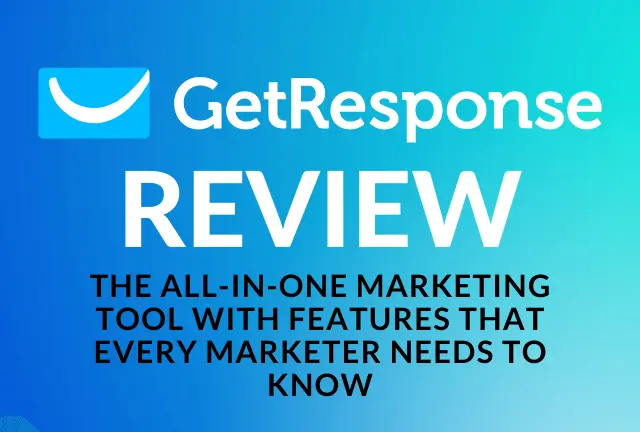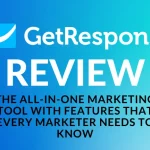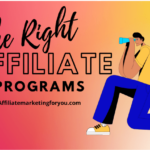GetResponse is an all-in-one marketing platform designed to help businesses of all sizes grow and succeed. With GetResponse, you can easily create and send newsletters, landing pages, and email campaigns that are tailored to your specific audience. Plus, GetResponse offers a range of marketing automation tools that allow you to easily segment and target your audience, as well as track and analyze the results of your campaigns.
One of the key features of GetResponse is its intuitive drag-and-drop email editor, which makes it easy to create professional-looking emails without any design or coding experience. Whether you’re a small business owner, a blogger, or a marketing professional, GetResponse has something to offer.
In addition to its email marketing capabilities, GetResponse also offers a range of other tools and features that can help you grow your business. For example, you can create landing pages to capture leads and sales or use the platform’s marketing automation tools to send targeted messages to specific segments of your audience.
Some of the main features of GetResponse include:
- Email marketing: GetResponse provides a range of email marketing tools and features, including customizable templates, automation, segmentation, and A/B testing. These tools allow businesses to create and send professional-looking emails to their subscribers, automate campaigns based on subscriber behavior, and segment their lists to send targeted messages.
- Marketing automation: GetResponse’s marketing automation features allow businesses to create automated campaigns based on specific triggers, such as signing up for a newsletter or making a purchase. These campaigns can include emails, landing pages, and forms, and can be customized to fit the needs of the business.
- Landing pages and forms: GetResponse’s landing page and form builder tools allow businesses to create professional-looking pages and forms for their website. These tools are fully customizable and can be integrated with other platforms, such as social media and CRM systems.
- Integrations: GetResponse offers a variety of integrations with other platforms, such as social media, CRM systems, and e-commerce platforms. These integrations allow businesses to seamlessly connect their marketing efforts across multiple platforms and enhance the overall effectiveness of their campaigns.
- Customer support: GetResponse provides 24/7 customer support through phone, email, and live chat. The company also has a wealth of online resources, including guides, tutorials, and webinars, to help users get the most out of their platform.
Email Marketing:
GetResponse offers a range of email marketing tools and features to help businesses create and send professional-looking emails to their subscribers. Some of the main email marketing tools and features offered by GetResponse include:
- Templates: GetResponse provides a variety of customizable email templates, ranging from simple newsletters to more complex campaigns. These templates are fully customizable and can be easily edited using the drag-and-drop editor.
- Automation: GetResponse’s automation features allow businesses to create automated campaigns based on specific triggers, such as signing up for a newsletter or making a purchase. These campaigns can include emails, landing pages, and forms, and can be customized to fit the needs of the business.
- Segmentation: GetResponse’s segmentation tools allow businesses to divide their email lists into smaller groups based on specific criteria, such as location, interests, or behavior. This allows businesses to send targeted messages to specific segments of their audience, increasing the effectiveness of their campaigns.
- A/B testing: GetResponse’s A/B testing feature allows businesses to test different versions of their emails to see which one performs better. This can help businesses optimize their campaigns and improve their results.
Automation:
GetResponse’s marketing automation features allow businesses to create automated campaigns based on specific triggers, such as signing up for a newsletter or making a purchase. These campaigns can include emails, landing pages, and forms, and can be customized to fit the needs of the business.
To create a marketing automation campaign with GetResponse, users can select from a range of pre-built templates or create their own custom campaign from scratch. Users can then define the triggers for their campaign, such as subscribing to a newsletter or making a purchase and specify the actions that should be taken, such as sending an email or displaying a form.
There is a wide range of campaigns that businesses can create using GetResponse’s marketing automation features, including:
- Welcome campaigns: These campaigns are designed to greet and engage new subscribers, and can include a series of emails or other actions, such as displaying a form or redirecting to a landing page.
- Abandoned cart campaigns: These campaigns are designed to recover lost sales by reminding customers about items they left in their shopping cart. They can include a series of emails or other actions, such as displaying a form or redirecting to a landing page.
- Lead nurturing campaigns: These campaigns are designed to guide potential customers through the sales process, by providing them with valuable content and offers. They can include a series of emails or other actions, such as displaying a form or redirecting to a landing page.
- Customer retention campaigns: These campaigns are designed to keep existing customers engaged with your business, by providing them with valuable content and offers. They can include a series of emails or other actions, such as displaying a form or redirecting to a landing page.
Landing Pages:
GetResponse’s landing page and form builder tools allow businesses to create professional-looking pages and forms for their website. These tools are fully customizable and can be integrated with other platforms, such as social media and CRM systems.
To create a landing page or form with GetResponse, users can select from a range of pre-built templates or create their own custom page or form from scratch using the drag-and-drop editor. The editor includes a range of customization options, such as text formatting, images, and buttons, as well as integrations with other platforms, such as Google Analytics and Facebook Pixel.
In terms of customization options, GetResponse’s landing page and form builder tools offer a variety of features, including:
- Customizable templates: Users can select from a range of customizable templates or create their own custom page or form from scratch.
GetResponse’s landing page and form builder tools offer a variety of customization options to help businesses create professional-looking pages and forms. These options include the ability to add text, images, buttons, and other elements to the page or form, as well as the ability to customize the layout and design of the page or form.
- A/B testing: GetResponse’s landing page and form builder tools include an A/B testing feature that allows businesses to test different versions of their pages and forms to see which one performs better. This can help businesses optimize their pages and forms and improve their results.
- Drag-and-drop editor: The drag-and-drop editor allows users to easily customize the look and feel of their pages and forms, including text formatting, images, and buttons.
GetResponse’s landing pages and forms are designed to be responsive, meaning they will automatically adjust to the size of the device they are being viewed on. This ensures that the pages and forms look great on desktop computers, tablets, and smartphones.
- Advanced analytics: GetResponse’s landing page and form builder tools include advanced analytics features that allow businesses to track the performance of their pages and forms, including page views, conversions, and other metrics. This can help businesses understand how their pages and forms are performing and make informed decisions about their marketing efforts.
- Integrations: GetResponse’s landing page and form builder tools can be integrated with other platforms, such as social media and CRM systems, allowing businesses to seamlessly connect their marketing efforts across multiple platforms.
Conversion Funnel:
A conversion funnel is a visual representation of the steps a customer goes through before making a purchase or completing a desired action. The conversion funnel typically consists of several stages, including awareness, consideration, decision, and action.
In the context of GetResponse, the conversion funnel refers to the process of moving leads through the sales process, from initial awareness of a product or service to the final decision to make a purchase. GetResponse’s sales funnel builder is a feature that allows businesses to create and automate campaigns to move leads through the conversion funnel and increase conversions.
To use the conversion funnel in GetResponse, businesses can create a sales funnel using the platform’s templates or custom drag-and-drop editor. The sales funnel can include a variety of steps, such as email campaigns, social media integrations, and other marketing efforts, to move leads through the funnel and increase conversions.
GetResponse’s conversion funnel also includes analytics and reporting tools that allow businesses to track the performance of their campaigns and gather insights about their audience. This can help businesses optimize their campaigns and improve their results.
Integration:
GetResponse offers a variety of integrations with other platforms to help businesses seamlessly connect their marketing efforts across multiple platforms and enhance the overall effectiveness of their campaigns. Some of the main integrations available with GetResponse include:
- Social media platforms: GetResponse can be integrated with various social media platforms, such as Facebook, Instagram, and LinkedIn, allowing businesses to easily connect their social media accounts and share their marketing campaigns with their followers.
- CRM systems: GetResponse can be integrated with various CRM systems, such as Salesforce and HubSpot, allowing businesses to seamlessly connect their customer relationship management efforts with their marketing campaigns.
- E-commerce platforms: GetResponse can be integrated with various e-commerce platforms, such as Shopify and WooCommerce, allowing businesses to easily connect their online stores and track the performance of their marketing campaigns.
- Google Analytics: GetResponse can be integrated with Google Analytics, allowing businesses to track the performance of their marketing campaigns and gain insights into their audience and traffic.
- Other marketing tools: GetResponse can be integrated with a variety of other marketing tools, such as webinar platforms, survey tools, and customer feedback tools, allowing businesses to connect their marketing efforts across multiple platforms.
Webinars:
GetResponse offers a webinar platform that allows you to host live or automated webinars, as well as schedule and promote them to your subscriber.
GetResponse’s webinar tool is a feature that allows businesses to host live or automated webinars to engage and connect with their audience. The webinar tool includes a range of features, including the ability to schedule and promote webinars, host live Q&A sessions, and generate leads through registration forms.
To use the webinar tool, businesses can simply create a new webinar event and customize it to fit their needs. This includes setting the date and time of the event, choosing a webinar template, and adding any necessary features, such as registration forms or polls.
Once the webinar event is set up, businesses can use GetResponse’s promotional tools to promote the event to their audience, including email marketing campaigns and social media integration. During the webinar, businesses can use the platform’s live Q&A and chat features to engage with their audience and answer questions in real time.
After the webinar is over, businesses can use GetResponse’s analytics and reporting tools to track the performance of the event and gather insights about their audience. This can include metrics such as attendance, engagement, and lead generation.
Customer support:
GetResponse provides a range of customer support options to help users get the most out of their platform. The company offers 24/7 customer support through phone, email, and live chat, and has a wealth of online resources, including guides, tutorials, and webinars, to help users learn how to use the platform.
In terms of response time, GetResponse’s customer support team is generally very responsive, with most inquiries being addressed within a few hours. The company also has a dedicated support team for enterprise customers, which provides more personalized and in-depth support for businesses with larger teams or more complex needs.
In terms of helpfulness, GetResponse’s customer support team is generally very knowledgeable and helpful, with a strong track record of helping users resolve issues and get the most out of their platform. The company also has a customer success team that is dedicated to helping businesses achieve their goals and grow their audience.
Overall, GetResponse’s customer support is comprehensive and user-friendly, with a range of options and resources to help users get the most out of their platform.
Pricing:
GetResponse offers a free plan and a range of pricing plans and options to suit the needs of businesses of all sizes. The company has four main pricing plans: Basic, Plus, Professional, and Max, with each plan offering a different set of features and tools.
The Getressponse free plan is called the “Free” plan and is suitable for small businesses with up to 1,000 subscribers. It includes many of GetResponse’s core features, such as email marketing, marketing automation, landing pages, and forms, but does not include some of the more advanced features, such as webinars and CRM integrations.
A free plan is a good option for small businesses that are just starting out and want to try out the platform before committing to a paid plan. It allows businesses to get a feel for GetResponse’s features and see how they can benefit their marketing efforts.
However, it’s important to note that the free plan has some limitations, such as a limited number of emails per month and no access to customer support. If a business needs access to more advanced features or higher levels of customer support, it will need to upgrade to one of GetResponse’s paid plans.
Overall, GetResponse’s free plan is a good option for small businesses that want to try out the platform and see how it can benefit their marketing efforts.
The Basic plan is the entry-level plan and is suitable for small businesses with up to 1,000 subscribers. It includes most of GetResponse’s core features, such as email marketing, marketing automation, landing pages, and forms, but does not include some of the more advanced features, such as webinars and CRM integrations. The Basic plan starts at $15 per month for up to 1,000 subscribers.
The Plus plan is suitable for small businesses with up to 5,000 subscribers and includes all of the features of the Basic plan, as well as some additional features, such as CRM integrations, webinars, and advanced automation. The Plus plan starts at $49 per month for up to 5,000 subscribers.
The Professional plan is suitable for medium-sized businesses with up to 10,000 subscribers and includes all of the features of the Plus plan, as well as some additional features, such as predictive sending and custom domains. The Professional plan starts at $99 per month for up to 10,000 subscribers.
The Max plan is suitable for large businesses with over 10,000 subscribers and includes all of the features of the Professional plan, as well as some additional features, such as dedicated IP addresses and priority support. The Max plan is customized based on the needs of the business.
GetResponse also offers a range of discounts and promotions throughout the year, including discounts for annual subscriptions and special offers for new customers.
Overall, GetResponse’s pricing plans are flexible and offer a range of options to suit the needs of businesses of all sizes. The company also offers a range of discounts and promotions to help businesses save on their marketing efforts.
Pros Vs Cons:
Here are some pros and cons of using GetResponse:
Pros:
- Comprehensive features: GetResponse offers a range of comprehensive features, including email marketing, marketing automation, landing pages, and forms, making it an all-in-one marketing platform for online marketers’ needs.
- User-friendly interface: GetResponse has a user-friendly interface and intuitive navigation, making it easy for users to access and use the various tools and features offered by the platform.
- Customization options: GetResponse’s tools and features offer a variety of customization options, including templates, drag-and-drop editors, and integrations with other platforms, allowing businesses to tailor their marketing efforts to their specific needs.
- Excellent customer support: GetResponse provides excellent customer support through a range of options, including phone, email, and live chat, as well as a wealth of online resources, such as guides and tutorials.
Cons:
- Price: While GetResponse’s pricing plans are competitive, they may be out of reach for some small businesses or startups with limited budgets.
- Limitations on the free plan: The free plan offered by GetResponse has some limitations, including a limited number of emails per month and no access to customer support, which may not be suitable for all businesses.
- Complexity: Some users have reported that GetResponse can be complex to use, especially for those who are new to online marketing. It may take some time for users to become familiar with all of the features and tools offered by the platform.
Overall, GetResponse is a comprehensive online marketing platform that offers a range of tools and features to help businesses grow and engage with their audience. While the platform has its pros and cons, it is generally well-regarded by users and is a solid choice for businesses looking for an all-in-one marketing solution.
Conclusion:
GetResponse offers a range of tools and features, including email marketing, marketing automation, landing pages, and forms, making it an all-in-one marketing tool for online marketing needs. The platform has a user-friendly interface and intuitive navigation, making it easy for users to access and use the various tools and features offered by the platform.
Additionally, GetResponse’s tools and features offer a variety of customization options, including templates, drag-and-drop editors, and integrations with other platforms, allowing businesses to tailor their marketing efforts to their specific needs. The platform also provides excellent customer support through a range of options, including phone, email, and live chat, as well as a wealth of online resources, such as guides and tutorials.
However, it’s important to note that GetResponse’s pricing plans may be out of reach for some small businesses or startups with limited budgets, and the free plan offered by GetResponse has some limitations, including a limited number of emails per month and no access to customer support. Additionally, some users have reported that GetResponse can be complex to use, especially for those who are new to online marketing.
Overall, GetResponse is a comprehensive online marketing platform that offers a range of tools and features to help businesses grow and engage with their audience. Whether or not it is a good fit for your needs will depend on your specific business and marketing goals.







